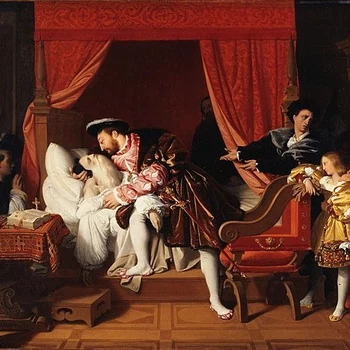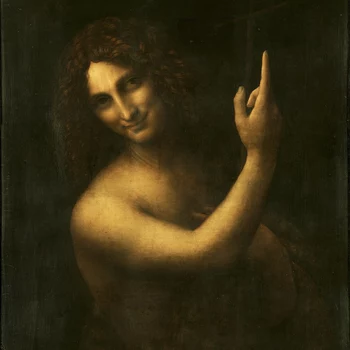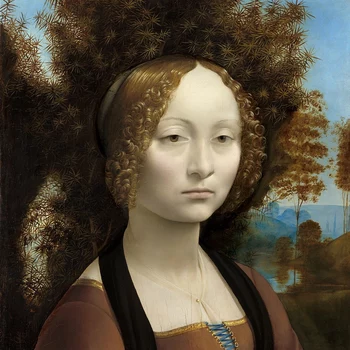Leonardo's finances
How much money did Leonardo's family have?
Leonardo da Vinci's paternal family was prosperous, but not exceptionally rich. They owned land in Vinci, which they leased to local farmers. The yields brought in enough money to live on.
What did Leonardo live on?
Leonardo worked only a few years as an independent painter. Most of the time he was a member of noble courts and received a basic salary (apanage). He worked there as an advisor and executive on all matters of urban development, engineering, science and art. He also accepted students who paid an apprenticeship fee.
How much did Leonardo earn?
Leonardo was most of the time employed at noble courts and got there between 1000 and 2000 gold ducats per year (3.5-7kg gold). That corresponds to a today's purchasing power of approx. 1.7 - 3.3 million euro. In addition, there were gifts of land and other trade goods.
How rich was Leonardo da Vinci?
When Leonardo da Vinci died, he had bank assets in Florence of 400 gold ducats (1.4kg of gold). In addition, there were properties in Milan and Florence that yielded annual rental income. The Duke of Milan had also given him rights to draw water from the St. Christopher canal, which also brought in regular income.
The family property of the Vincis
Leonardo's male ancestors had been affluent notaries in Florence for generations. During that time, it was a common practice for well-off citizens of Italian cities to purchase countryside properties where they would spend the hot summers. Leonardo's family also began acquiring land in and around Vinci, a village near Florence. Over the decades, this grew into a considerable estate, including several houses and farms that were leased to local residents.
The rent was typically paid in kind, such as grain, olive oil, or wine. The income generated from these leases provided the Vinci family with enough financial security to be independent. Furthermore, they continued expanding their properties over the years. This allowed some family members to avoid regular employment and focus solely on managing the family holdings. Leonardo's grandfather, Antonio, and his uncle, Francesco, followed this path.
Leonardo likely grew up on the family's Vinci properties. While life there was comfortable, it was still modest, rural, and simple. The Vinci family did not live in luxury.

Characteristic of Tuscany are isolated country houses surrounded by olive groves or vineyards

To the right, behind the large hills in the background, lies Florence, approximately 25 km away as the crow flies
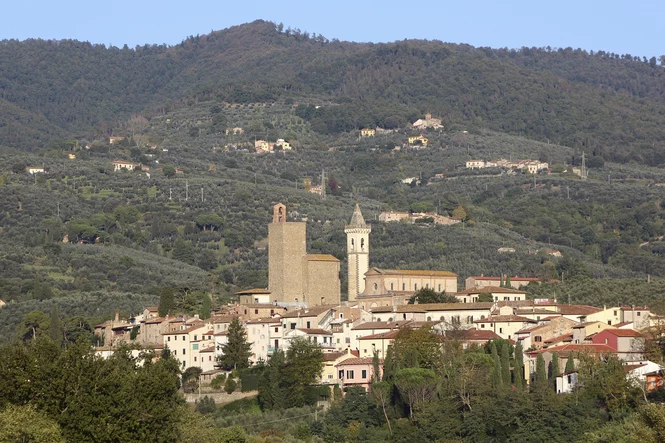
In the center of the village, two characteristic towers rise up
Leonardo's hard early years
Leonardo moved from Vinci to Florence at the age of 12-16 and, through the intercession of his influential father, began an apprenticeship as a painter under the then very famous artist Andrea del Verrocchio.
Although Leonardo was admitted to the Florence painters' guild as a master in 1472, at the age of 20, he continued to work under his old teacher Verrocchio for another six years. It was not until 1478 that Leonardo set up on his own as a painter in Florence and founded an artist's workshop. Leonardo was 26 years old at this time. From the beginning he had his own horses, servants and also already some pupils.
Leonardo initially had great difficulty in obtaining lucrative commissions. In fact, it was only through the mediation of his father, a well-known and well-connected notary, that Leonardo received a few commissions, e.g. he was to paint the altarpiece for the chapel of the Florentine city parliament. However, Leonardo later gave the project to a former classmate.
The Gagging Contract for the Adoration of the Magi
How much Leonardo was initially dependent on the support of his father is shown by the conclusion of the contract for the unfinished painting "Adoration of the Magi". The conditions were very unfavorable for Leonardo. He was given land worth 300 florins (1.05 kg of gold), but he was not allowed to sell it for another 3 years and only with the consent of the commissioning monastery. He had to donate 150 florins of it to a lady from the environment of the monastery, moreover immediately. 150 Florin was a high sum, which Leonardo could not raise. Therefore, the monastery lent him the amount. Thus he was already heavily in debt even before he had begun the work. Leonardo also had to pay for the paints and materials for the painting himself. On top of that came the ongoing upkeep of his workshop.
Experiences like this may have contributed to Leonardo's decision to leave for Milan three years later to work for the Duke of Milan (ca. 1482).
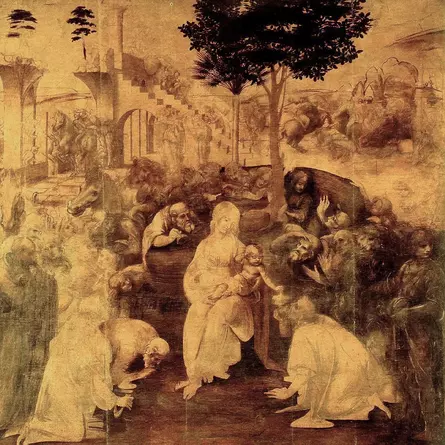
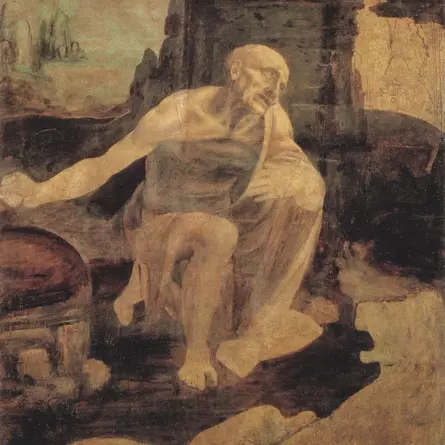
Leonardo's income
Leonardo painted very few paintings. At the same time, he always had servants, maids, pupils, horses, and pursued numerous activities that at first glance did not bring in any money. This raises the question of how he was able to finance his workshop business.
Income from apprenticeship fees
It was common for master painters to take on students and receive an apprenticeship fee from their parents. The amount of the fee varied with the social background of the student. In some cases Leonardo waived the fee. According to the understanding of the time, the training also included auxiliary work in the workshop, so that students not only lowered the costs of the workshop directly through teaching fees, but also indirectly by performing simple auxiliary work. Leonardo therefore always had several students around him.
Free board and lodging
The artists' workshops were not tied to a fixed location. Rather, they were a mobile group of people. If the commissions were further away and could only be executed on site (e.g. for wall paintings), it was customary for the clients to pay for the lodging and meals of the artist's workshop. For example, when Leonardo made the cartoon of Anne Selfless, the monks of the Florentine Servite Order provided room and board for him and the members of his workshop.
A wide range of workshop commissions
The main source of income for the artist's workshops was certainly the numerous workshop commissions. Paintings were the new fashion of the time and popular and expensively paid status symbols of the rich upper class. Sculptures were also very popular. But these were not the only types of commissions. Renaissance artists saw themselves as universal talents. This is true not only for Leonardo, but for all artists of the time. They painted, made music, wrote poetry, entertained, organized courtly festivities, designed buildings and machines, and sometimes just their advice or research on all sorts of things was needed. Accordingly, Leonardo exercised not only one but several professions.
Court artist
- portraits and paintings for court society (e.g. "The Lady with the Ermine", "La Belle Ferroniere" and "The Last Supper" were commissions from the Duke of Milan)
- making statues and statuettes
- artistic director of court festivals, entertaining special effects of all kinds, designing imaginative disguises and stage sets, making disguises for animals, e.g. squirrels, the animals prepared in this way were then released at the festivals
- Design of fountains
- construction of lifting platforms for theatrical performances
- musical entertainment of the guests: Leonardo played various instruments, some of which he built himself, and sang melodiously to them, he was known for being able to improvise well
- amusement of the company with interesting riddles and instructive stories
- Special creations: a mechanical robot knight that could walk on its own; an automobile that could drive on its own by being driven by a mechanical tension spring like an oversized wind-up car; on the occasion of a visit of the French king, a mechanical lion was made that could walk a few steps and open its mouth via a wind-up mechanism
Architect
- Assistance in all matters of urban planning
- Supervision of building projects, e.g. reconstruction or new construction of villas, palaces and churches
- extension of sewerage systems
- Drainage projects
- Surveying projects, drawing up maps
- Preparation of plans for fortifications
Engineer
- Design of all kinds of machines to facilitate work
- designs and plans for weapons of war, siege weapons and mobile bridges
Scholar
- Leonardo was a contact person and advisor to the court in all matters of science
The wide range of commissions shows that Leonardo was active in many fields and that making paintings was only one of many tasks.
Court appanage
Members of a noble court received an annual basic salary to cover their expenses, an apanage. Leonardo was largely employed at such courts. Payments were not always made regularly, and letters from Leonardo to the Duke of Milan have been preserved, asking him to make the outstanding payments. One begins like this: "Serene Highness, since I still have to receive the wages for two years ...". The Duke of Milan was known for his iron budget discipline.
Apanage in Milan
Nevertheless, Leonardo was paid extraordinarily well. He was once asked by a visiting cardinal what salary he received from the Duke. Leonardo replied that he usually received two thousand ducats a year (7 kg of gold), plus numerous gifts and presents with which the duke lavished him most generously every day. Thus, in 1499, shortly before his expulsion by the French, the Duke gave Leonardo a vineyard near Milan.
Apanage in Amboise
When Leonardo lived at the court of the French king at the end of his career, he received 1000 gold ducats per year (3.5kg of gold) as "the king's painter", only half the salary in Milan. However, the highest royal official got exactly the same sum. So the amount of the salary was a court political decision. In addition, Leonardo was given the castle Château du Cloux, 500m away from the royal castle.
Real Estate
In his later years, Leonardo owned some real estate properties that brought in additional income.
The Vineyard in Milan
Leonardo had been working for Duke Ludovico Sforza of Milan since around 1487. As a token of appreciation for his long service, the Duke granted the 47-year-old Leonardo a vineyard through an edict dated April 26, 1499:
"Ludovico Maria Sforza granted to Leonardo da Vinci, the highly renowned painter from Florence, 16 rods of land [about an area of 80m × 80m] or a vineyard, which he had recently acquired from the abbot or the monastery of San Vittore on the outskirts, near the Vercelli Gate [in the west of Milan], for him to build as he sees fit on this land and to establish orchards and do anything else he or his descendants or those to whom he will give what he received above may do or dispose of.
A few days later, the French conquered Milan and expelled the Duke. Leonardo left the city in the fall of the same year in search of new patrons and returned to Milan only in 1406 to work for the French. In the meantime, the vineyard was leased by Leonardo's student Salai, who allowed his father to live there. Later, Salai also settled there. In Leonardo's will, he bequeathed half of the vineyard to Salai, and the other half went to Leonardo's servant Vilanis.
The Properties in Vinci
It is unclear today how much land from the da Vinci family's possessions was transferred to Leonardo. As an illegitimate son, Leonardo was excluded from his father's inheritance, but his childless paternal uncle specifically named him as the sole heir.
The properties in Vinci were once owned by Leonardo's grandfather Antonio. Although he was a trained notary, he lived in the countryside and "did nothing," as was the terminology of the time, meaning he managed the family's properties. After his death, the possession was likely divided between his two sons, Ser Piero and Francesco, as both owned land in and around Vinci. Leonardo's father, Ser Piero, was the eldest son and possibly received a larger share. Since he was a successful notary in Florence, he needed a local manager to oversee the properties in Vinci. This role may have been assumed by his brother Francesco because he, like his father, did not pursue any profession and "did nothing." This suggests that he had enough land to sustain himself from the yields. The idea of Francesco leading an idle life seems implausible since he had been married to Alessandra Amadori since 1465, who was the sister of his brother Ser Piero's first wife, who had died young. The da Vinci family had been strategically marrying women from Florentine notary families for generations. The marriage would probably not have taken place if Francesco's future livelihood had been uncertain.
When Francesco died childless in 1507, his entire estate was intended to go to his sole heir, Leonardo. Since Leonardo was an illegitimate child and an earlier testament of Francesco stipulated that only legitimate children of Ser Piero were entitled to inherit, a lengthy legal dispute ensued with Leonardo's brothers. However, the French king successfully advocated for Leonardo with the government of Florence. Leonardo came into possession of part of the family's properties in Vinci in 1508, when he was 55 years old. The exact extent of this inheritance cannot be determined today. Given the protracted legal dispute, it must have been a considerable sum, which was also significant enough for Leonardo's brothers, even though some of them had become notaries themselves and thus reasonably well-off.
The Navigable Canal of St. Christopher, Milan
Milan is not directly situated on a river or lake. In the Middle Ages, artificial canals (Navigli) were created to supply the city with water, connecting the surrounding lakes and rivers with the city. They also played a significant role in the local economy, as some of the canals were wide enough to allow larger ships to pass. The largest of these canals, the "Naviglio Grande," had its own small port. Parts of the Milan canal system have been preserved to this day.
Around 1508, the French king granted Leonardo the navigable canal of St. Christopher in Milan. At that time, this was a very valuable gift. On the one hand, it included the right to charge fees for water extraction for consumption, and on the other hand, fees could be levied for navigating the waterway. However, the transfer of the canal did not go smoothly, as a letter from Leonardo to the French governor of Milan still exists in which he complains that the canal had not yet been transferred to him. The fact that the canal was eventually transferred to Leonardo is evident from his will, in which he bequeathed the canal to his servant Vilanis.
How did Leonardo live?
Based on the few surviving historical sources, it is no longer possible to trace Leonardo's exact places of residence continuously. Furthermore, most of the buildings that Leonardo is known to have lived in have not survived. Nevertheless, some statements can be made about Leonardo's accommodations.
Childhood and Education
With a high probability, Leonardo spent his childhood on his family's estates in Vinci. In his youth, he moved to the center of Florence to live with his father, Ser Piero da Vinci. Ser Piero, a respected notary, had an office in the square in front of the government building, but the exact residential address of young Leonardo is unknown today. Similarly, it is unclear where Leonardo lived during his apprenticeship with his Florentine master, Andrea del Verrocchio. Due to their proximity, Leonardo might have lived with his father. Alternatively, he could have resided in Verrocchio's workshop. These artist workshops, called "bottegas," often had dedicated living spaces for the workshop's apprentices. In general, very little is known about Leonardo's life during this period.
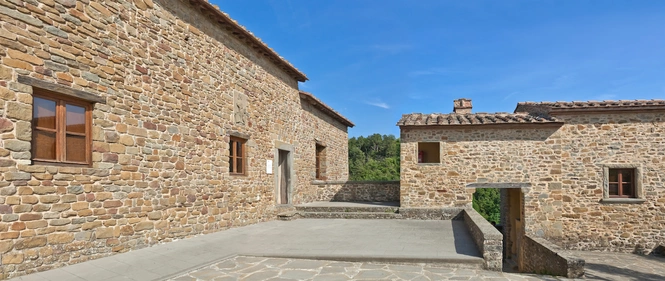
The standalone property consists of these two houses perpendicular to each other. Today, it houses a small museum

The Signoria was the city government of the Republic of Florence. The exact location of the notary office of Leonardo's father, Ser Piero, on the square is unknown today
Churches and Monasteries
Leonardo mostly resided in administrative buildings of churches or monasteries when working on paintings for religious clients.
- 1482, San Vincenzo, Milan
When Leonardo left Florence and moved to Milan, he worked for about three years on his first unquestionably genuine and completed painting, the "Virgin of the Rocks." The altarpiece was originally commissioned by the Confraternity of the Immaculate Conception for the Franciscan church of San Francesco Grande in Milan. During the work on the painting, Leonardo lived, at least temporarily, in the parish of the church of San Vincenzo - 1502, Santissima Annunziata, Florence
Upon returning to Florence, the monks of the Servite Order provided him with rooms in their monastery to paint an altarpiece. Leonardo later handed over the commission to a painter from the circle of his master Verrocchio, Filippino Lippi - Around 1504, Santa Maria Novella, Florence
During the work on the painting "The Battle of Anghiari," Leonardo lived in an outbuilding of the church of Santa Maria Novella. The commission for the colossal painting came from the city government of Florence - 1510, Parish of Santa Babila (near Porta Orientale), Milan
It is noteworthy that Leonardo spent some time there because he was concurrently in the service of the French governor of Milan and could have lived at his court
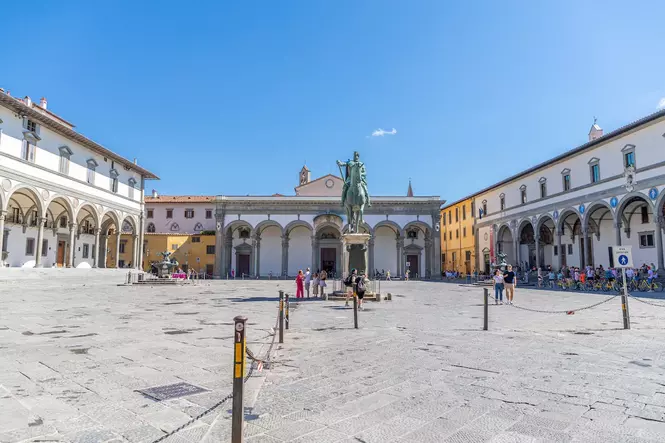
On the left is the Ospedale degli Innocenti (Hospital of the Innocents) designed by Filippo Brunelleschi († April 15, 1446). Brunelleschi is known for creating the dome of the Florence Cathedral, which was the largest dome in the world for the next 400 years. During Leonardo's apprenticeship in the workshop of his master Verrocchio, a 2-meter-tall gilded copper ball was crafted, which now sits atop the cathedral's dome. The church of the Servite Order is in the center of the image. To the left behind it is the monastery area where Leonardo lived at times. The seven-arched entrance area on the right was added in 1601. To the right is the Loggiato dei Servi, designed by Leonardo's contemporary Antonio da Sangallo the Elder
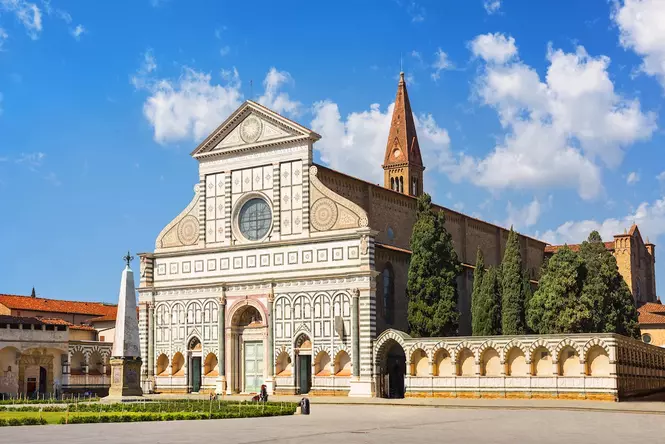
The facade of the church was designed by the architect Leon Battista Alberti († April 25, 1472), although it was realized in his absence. Leonardo adopted Alberti's enthusiasm for the primarily intellectual design of architecture. The building contains or once contained famous paintings such as Masaccio's Trinity, the first painting with correct central perspective, and Botticelli's Adoration of the Magi. Around 1504, during the work on the painting "The Battle of Anghiari," Leonardo lived in an outbuilding located to the left behind the church
Noble Courts
Leonardo spent most of his life working at noble courts, where he was provided with rooms to use as workshops and accommodation.
- 1489-1499, Corte Vecchio (not preserved), Milan
Leonardo resided in Corte Vecchio, the former residence of the Visconti noble family, rulers of Milan. His fellow residents there included the legitimate Duke of Milan, Gian Galeazzo Sforza, who was displaced by Ludovico Sforza. In the large courtyard of the square-shaped palace, Leonardo created the 7-meter-tall plaster model of his equestrian statue for Francesco Sforza - 1506-1508, Castello Sforza (preserved), Milan
The former palace complex of Ludovico Sforza, now preserved, was used by the French Governor Charles d’Amboise after Ludovico's expulsion. When Leonardo worked for him, he occupied some rooms there - 1513-1516, Belvedere Palace (significantly altered), Rome
Leonardo was provided with living quarters and a studio in the present-day Belvedere Palace next to St. Peter's Basilica. These accommodations were arranged by the brother of the Medici Pope Leo X. - 1516-1519, Château du Clos Lucé (preserved), Amboise
Château d'Amboise, along with Château de Blois, served as the French royal residence at the time. Leonardo lived in Château du Clos Lucé, located about 500 meters from Château d'Amboise
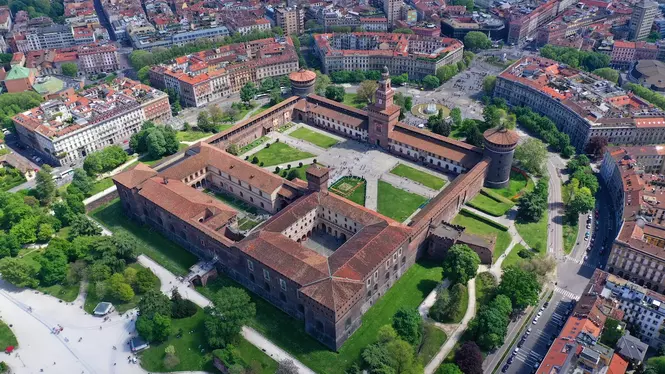
The castle in the center of Milan was the court of the Dukes of Milan. Leonardo was provided with some rooms there around 1506-1508
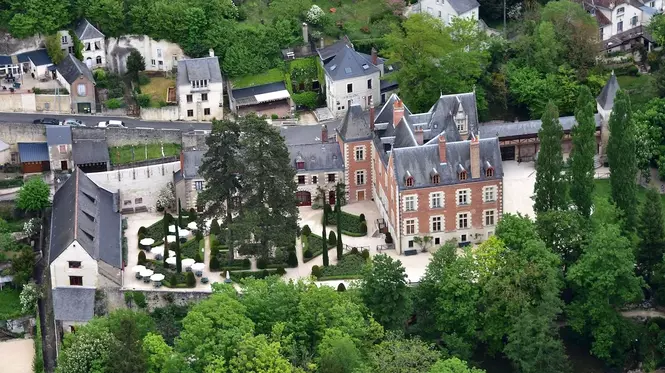
Leonardo's residence from 1516 until his death in 1519
Accommodation with friends and acquaintances
In times of political upheaval, when the order situation was unclear or when traveling, Leonardo stayed with friends and acquaintances.
- 1508, Palazzo Martelli (preserved), Florence
Leonardo temporarily lives in the palace of the wealthy art patron Piero die Braccio Martelli, when there were inheritance disputes over the family estate in Vinci - 1512-1513, Melzi Villa (preserved), Vaprio d'Adda, near Milan
When the Sforzas again seized power in Milan, Leonardo retreated for several months to the villa of his aristocratic Milanese pupil Francesco Melzi. Among other things, he drew plans there for the remodeling of the estate - 1513, Villa of Prevostino Viola (location unknown), Milan
Shortly before Leonardo is summoned by the Medici to the papal court in Rome, he stays with Prevostino Viola (known from an entry in the cathedral building register in Milan dated March 25, 1513). Nothing else is known about Prevostino Viola. From the entry it can possibly be concluded that he was a master builder at the Milan Cathedral. Possibly it is also a typographical error and actually means a Prevostino Piola, a historical person who lived at that time in Milan
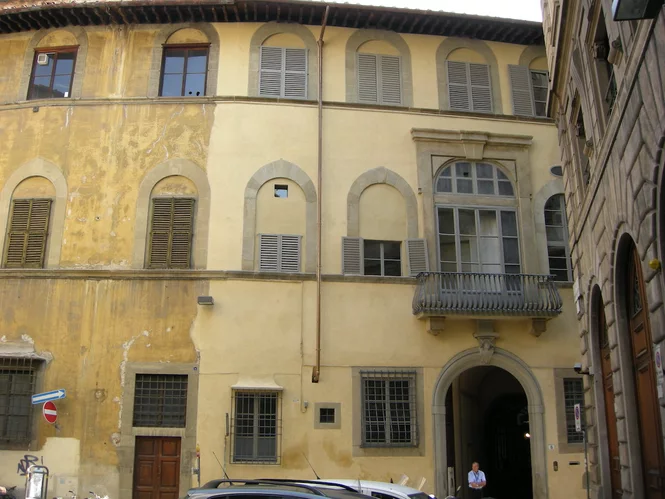
Leonardo stayed in the palazzo of Piero di Braccio Martelli around 1508. The building in the winding streets of Florence today belongs to the famous Barghelllo Museum and houses numerous art treasures.
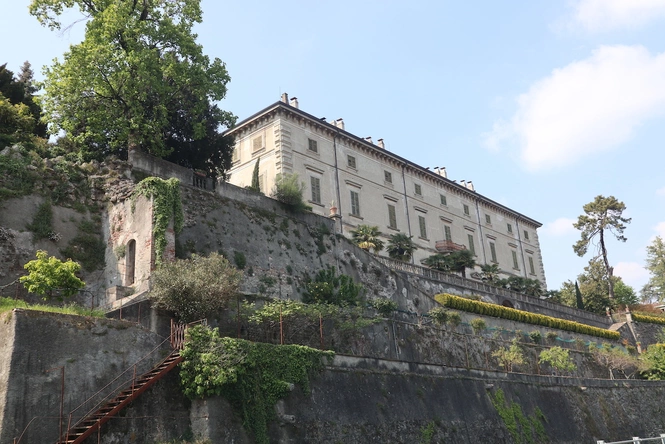
The Melzi Villa is situated on a rock above a bend of the Adda river
The Florin
In modern times, the basic currency for European trade was gold. It was cast into coins, which consisted almost of pure gold. The size of the coins was standardized throughout Europe. Their weight was 3.5g of gold. There were different names for these gold coins depending on the country, but they all meant the same thing. Ducat (Byzantine Empire), Guilder (Holy Roman Empire), Écu (France), Scudo (Genoa) and Florin (Republic of Florence) are just a few examples. Because of the enormous trading power of the Florentines and their highly developed international banking system, which extended throughout Europe, the florin was the most common coin. The florin featured a lily, the city arms of Florence, on the obverse and John the Baptist, patron saint of Florence, on the reverse.
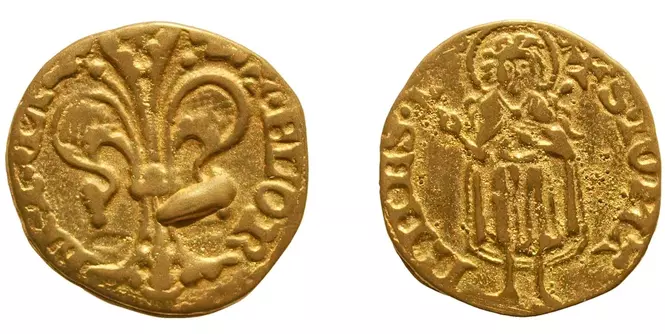
The coins are thin plates of pure gold.They have a diameter of about 1cm.The florin was the dominant currency in Europe in the 14th and 15th centuries.It was for Europe what the dollar is for the world today
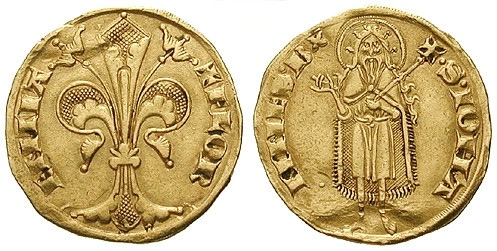
How was Leonardo paid?
Leonardo da Vinci was paid in florins. In addition, for smaller amounts in everyday trade, there were silver coins of lesser value and in various sizes. The denominations and units of silver coins varied greatly within Europe. For Leonardo's sphere of activity in northern Italy, there were the following units.
| Value unit | Weight | Material | Conversion |
|---|---|---|---|
| 1 denaro | 1.25g | silver | smallest unit of value |
| 1 quattrino | 5g | Silver | 4 denari |
| 1 soldo | 15g | Silver | 12 denari |
| 1 lira | No coin, Only unit of account | 20 Soldi | |
| 1 Fiorino (Florin) | 3.5g | Gold | 4 lire |
In addition to gold-based currencies, barter transactions were also common for payment. It so happened that Leonardo received a cart of firewood for the repair of a church tower bell. He could consume this himself, barter it or sell it at a market.
What was the value of the coins?
- 2 chicken eggs cost one denaro
- 15 florins were enough for the annual living of a person who was neither rich nor poor
- A very good painter could charge between 100 and 300 florins, depending on the size of the painting
- A small estate with a purchase value of 250 florins brought a rent that could support a family of four
- the second richest citizen of Florence in 1457 was Amerigo de' Benci with a fortune of about 26,000 florins (91kg of gold)
- when the French king invaded Florence in 1494, he demanded 120,000 florins for his withdrawal (420kg of gold)
That Amerigo de' Benci could be the second richest person in Florence with a fortune of just 91kg of gold is hard to comprehend today. Because 91 kg gold correspond to approx. 5.5 million euro (conditions 05/22).
Can the value of the gold be transferred to today?
The value of gold at that time cannot be transferred to today. The following points have to be considered
- There were far fewer people in the world at that time (only 6% of today's ~8 billion)
- Gold was in circulation in smaller quantity than today
- The number of different products and services was less than today
- The majority of people lived in rural areas. In these regions, trade was mainly based on the exchange of goods.
If these points are related to each other, gold had a higher purchasing power compared to today.
How much did Leonardo earn by today's standards?
The value of Leonardo's income can be well determined if it is put in relation to the annual income of an average citizen at that time.
| Income per year | Florence 1500 | Germany 2020 (after taxes) |
|---|---|---|
| Average citizen (neither rich, nor poor) | 15 Florin | 25.000 Euro |
| Master craftsman | 30 Florin | 50.000 Euro |
| Leonardo's income | 2000 Florin | 3,3 Mio Euro |
Accordingly, Leonardo's annual income at that time would have a purchasing power of 3.3 million euros today. However, this is not Leonardo's personal income, but rather the turnover of his workshop business. From this amount he had to pay the hired servants and assistants and also other painters or master craftsmen who assisted him with his orders. In addition, there were costs for materials and other equipment. But even after deducting the costs, there was enough left over for Leonardo to finance his lavish lifestyle.
Leonardo's spendings
When Leonardo died in 1519, he had a bank fortune in Florence of 400 florins (1.5kg of gold). That is strikingly little, if this sum is held against the annual incomes of Leonardo. Because already in his Milan time he received according to traditional statement an annual wage of 2000 Florin (7kg gold). From this imbalance it is often concluded that Leonardo could not handle money. This is also said to explain the demands for payment from some creditors, which have survived to this day.
Lifestyle
Throughout his life, Leonardo moved in the highest circles of society and partly adopted their way of life. Thus, he preferred comfortable clothes made of fine fabrics. He was very generous and also furnished the members of his workshop. Nevertheless, it would be an exaggeration to describe his life as luxurious. Rather, according to his records, he tended toward modesty and propagated a reduced lifestyle.
Leonardo's workshop
Leonardo ran an artist's workshop during the Renaissance. However, the term artist's workshop falls short. Rather, these workshops were artisanal enterprises that also performed numerous other activities, depending on the skill of their masters.
For example, Leonardo's teacher Verrocchio was the sculptor responsible for the design of the golden dome with cross, a replica of which can still be found on Florence Cathedral. It was natural at the time that Verrocchio also designed the machines and cranes that lifted the dome, which is about 1m tall, into the air.
Leonardo's workshop was thus rather a company with several main focuses:
- Production of art products
- Planning and realization of festivities and processions
- Consulting, planning and execution of engineering services
- Preparation of scientific reports
Clients of the company were wealthy citizens, the high nobility and the church.
Costs of the workshop
Leonardo's company had a basic staff. This included servants, maids, and freelance specialists who were called in depending on the job (e.g., mirror makers, other painters). The company also needed basic equipment, such as working materials, horses and carriages. The materials Leonardo used were always of high quality. For example, he did not use conventional paints, but made them himself from precious minerals. He also used special alloys and woods for the components of his machines. His wide-ranging interests led to numerous cost-intensive experiments, which initially brought the workshop nothing and only served experimental purposes.
Leonardo's income therefore did not go directly into his fortune, but largely paid for the running costs of his workshop. This explains why Leonardo had a relatively small bank balance at the time of his death. However, the sum of 400 florins (1.4kg of gold) also suggests that Leonardo certainly had no money worries.
Thefts
Another reason for the constant outflow of funds was that banking was not yet particularly well developed in everyday life. Thus Leonardo had to keep some of the gold coins in his workshop. There are preserved notes from 1.4.1499 with a kind of cash balance, in which he noted his hiding places. They give a vivid impression of how Leonardo kept his cash:
"[...] 20 ducats in the corner where the nails are, in white paper.
28 ducats next to the corner where the nails are, in blue paper.
97 ducats in the corner by the cabinet above the iron rings.
In white paper in the opposite corner above the iron rings 17 double ducats, 1 double ducat, 25 grossoni.
In a cloth in the cash box, 140 ambrosini
In the pocket 206 Grossoni"
Grossoni and Ambrosini were obsolete silver coins at the time, but continued to circulate. Leonardo lists here a cash fortune of about 170 ducats. This was an enormous sum. By comparison, Leonardo's salary for the large-scale painting "Madonna of the Rocks," on which he was to work for 20 months according to the contract, was 200 ducats.
In his notes, Leonardo often complained about his pupil Salai, because he was stealing from him. It is conceivable that the latter was not the only one to plunder one of the hiding places, especially since they were apparently easily accessible. It is also conceivable that one or the other hiding place fell into oblivion.
Debt
The insufficiently developed banking system is also a reason for Leonardo's frequently mentioned debts. He was never unable to repay them, but money could not be easily transferred in the late Middle Ages. For example, if he was out of town for a few weeks, which happened especially after 1500, it took patience on the part of the creditors to claim the amount later when he returned. This explains reminders of this kind.
Moreover, Leonardo himself was often a creditor. Works were usually paid for only after completion, and payment morale was not particularly high. Even his noble courtiers, such as the Duke of Milan, made no exception and sometimes did not pay wages for years.
Other debts arose because of legal disputes. Leonardo believed himself to be in the right not to have to pay certain amounts due to contractual interpretations. Until these facts were clarified, he continued to owe the amounts. This can be seen in the 20-year legal dispute over the Virgin of the Rocks.
In conclusion, it can be stated that on the one hand Leonardo certainly had a financially carefree life, and it seems that he spent the money with full hands. On the other hand, he meticulously notes expenses even the smallest amounts. And takes legal action when large amounts of money are involved. Money, on the whole, seemed to have been a means to an end for him, but without being wasted.
Do not despise me because I am poor. Poor is only the one who desires too much.
Sources
Frank Zöllner, Leonardo, Taschen (2019)
Martin Kemp, Leonardo, C.H. Beck (2008)
Charles Niccholl, Leonardo da Vinci: Die Biographie, Fischer (2019)
Especially recommended
Marianne Schneider, Das große Leonardo Buch – Sein Leben und Werk in Zeugnissen, Selbstzeugnissen und Dokumenten, Schirmer/ Mosel (2019)
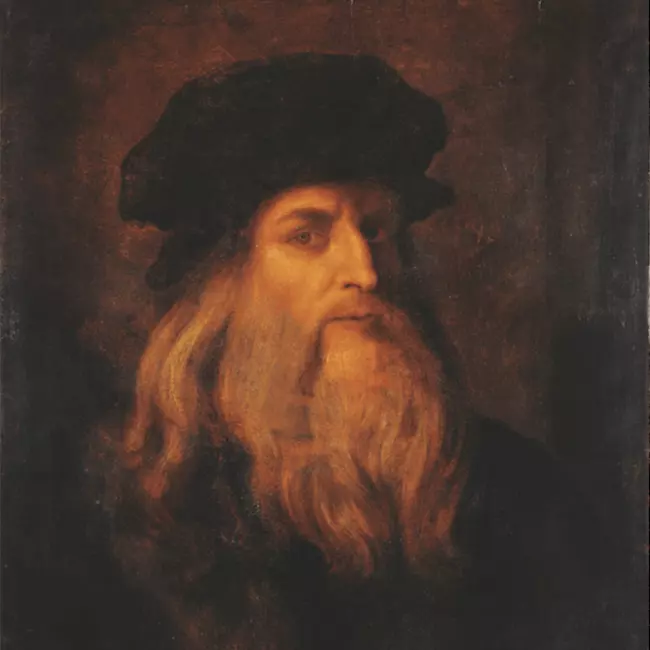
![[Translate to english:] [Translate to english:]](/fileadmin/_processed_/7/0/csm_anna-selbdritt_370c8646a0.webp.pagespeed.ce.NuSK1feNeY.webp)
